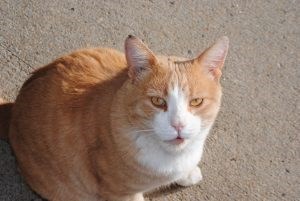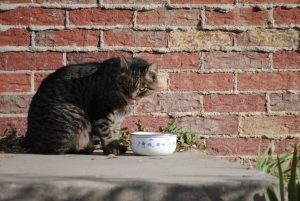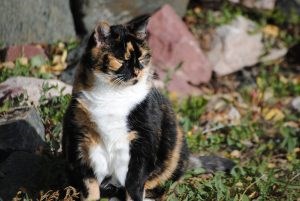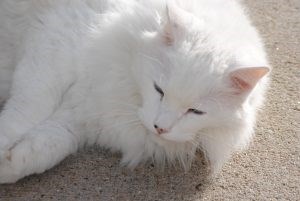This content was originally published by the Longmont Observer and is licensed under a Creative Commons license.
For the third installment of my Halloween series, I’m going to focus on feral cats. Monday, October 16, was declared Feral Cat Day in Longmont. I myself have been taking care of a couple of feral cats that showed up in my garage during a snowstorm and never left. The term feral cat refers both to cats that aren’t used to being around humans and aren’t friendly, as well as to cats that have been abandoned.
Cats lived outdoors for over 10,000 years, and it was only recently (as in about 70 years ago) that cats started living indoors. As humans developed agriculture and began to abandon nomadic lifestyles, rodents became attracted to grain stores. This ready and reliable food source attracted cats that decided to stick around. The original cat that hung out around human dwellings was not the same species as the domestic cat is today. The original species evolved into what we consider the domestic cat. Cats were spread around the world on ships that carried cats along to keep the rodent populations down.

By the end of the 19th century, people began keeping cats as companions. Initially, companion cats were allowed to roam freely. It was not until the advent of things like refrigeration, kitty litter, and spaying and neutering that keeping cats indoors became practical. Even though cats are now often kept as indoor pets, their behaviors and instincts have not evolved much from their ancestors. For example, cats still need a high protein diet as opposed to domesticated dogs that have adapted to an omnivorous diet. This is why refrigeration was important in allowing cats to become indoor pets. Unless cats were able to supplement their diet by hunting, owners could not feed them properly. Most Americans could not afford extra fresh meat or fish, so canned cat food was important, but needed refrigeration.
Feral cats are skilled at finding food and shelter. Studies show that feral cats can be just as healthy as pet cats and may even have as long a life span. Some people worry that feral cats will spread diseases, but the science does not support this. For one thing, feral cats typically are not friendly with people and avoid them, reducing the chances that any disease could be spread. A study published in the Archives of Internal Medicine concluded that cats were not a vector of disease spread to humans. The Centers for Disease Control agrees with this conclusion, and showed that as a vector for rabies, feral cats are insignificant. Most cat diseases are spread to other cats. People who care for feral cat colonies do not show a higher incidence of diseases associated with cats than do the general public.

Another concern people have with feral cats is their impact on wildlife. Although studies have been conducted on the impact of outdoor cats on wildlife, there is still disagreement as to the extent of the impact. Humans likely play a much larger role in decreasing wildlife populations through actions such as habitat destruction and pesticide use. Feral cats are opportunistic feeders, often feeding on scraps of food in human garbage. One study in Brooklyn found that garbage was the main food source for one cat colony, despite having access to wildlife and cat food placed by humans. Studies also show that the main food sources for cats when they do hunt are rodents and insects. This is due to the fact that cats are more efficient at sitting and waiting for prey than they are at stalking prey. Some studies show that small mammals are consumed by feral cats three times as often as songbirds. In fact, studies show that often the birds taken by feral cats are among the most common species in the area, and they tend to be more diseased or weakened.
Feral cats generally cannot be “rehabilitated” to be indoor cats. In many places, feral cats that end up at the shelter are euthanized because they cannot be adopted. The Longmont Humane Society, however, has a barn cat program that adopts cats that are not suitable for indoor living. In addition, the Longmont Friends of Feral and Abandoned Cats helps with a Trap-Neuter-Release program. This helps keep the population of cats down humanely. Cats that have been neutered typically will have a portion of their ear removed (called ear-tipping) so that caretakers can quickly identify whether a cat has already been neutered. This not only keeps the cat healthier, but prevents a vacuum from forming that would occur if the feral cats had been removed altogether. Removal of feral cats from an area creates a vacuum that other feral cats will then move into.

If you have feral cats near your house that you do not want living near you, there are things you can do to discourage them from hanging out. The most obvious thing is to remove any potential food sources. You can also use sprinklers to wet your lawn, playing on cats’ dislike of water. Just be sure to water a different area each day so that cats don’t know what to expect. Sometimes, you will find a cat that doesn’t care about the water. In this case, there are commercial repellents you can use. Plants such as rue, citronella, lemongrass, eucalyptus, and lavender are also thought to repel cats. Adding citrus peels, coffee grounds, tobacco and white vinegar to mulch in your garden may keep cats at bay as well. To prevent cats from digging in your lawn or garden, you can use a plastic carpet runner placed with the spike side up. Lightly cover the carpet runner with soil. This won’t injure the cat, but will keep them from digging. Chicken wire or lattice can achieve the same results. You can minimize cat urine smells with white vinegar or commercial enzymatic products.
If you don’t mind the feral cats, you can use the above techniques to keep them out of certain areas and use the following techniques to attract them to the areas you don’t mind them being in. Planting catnip and letting the grass grow taller will attract cats. Place the catnip near a perch from which the cat can see its surroundings. If you don’t have a tree or a fence available, you can easily make a perch. Tilling the soil or putting sand in a particular area will encourage feral cats to use that area as a litter box instead of just any old place in your yard. Of course, you will need to keep it clean. A shelter similar to a dog house can be provided. Just make sure it has a couple of entrances so that the cat can’t be trapped by another cat or predator. Feed cats at the same time each day with only enough food to finish within one sitting. Leftover food should be brought in after an hour and cats should not be fed at night.

Finally, I thought I’d finish up with some fun cat facts. Cats can’t see directly beneath their noses, so they miss food that is literally right in front of their nose. Cats noses have a ridged pattern on them that is as unique to each individual as a fingerprint. The cat door was invented by Isaac Newton because his cat kept opening the door and interfering with his experiments. Female cats are called “mollies” or queens whereas male cats are called toms. Cats sweat through the pads on their paws. A domestic cat can run up to 30 miles per hour. The more time you spend talking to your cat, the more likely your cat will start to meow and chirp back at you. Cats can make up over 100 vocal sounds, some of which are inaudible to the human ear. Cats generally give 26 purrs per minute, the same rate as an idling diesel engine. So that’s it for this week. Enjoy the fall weather!


